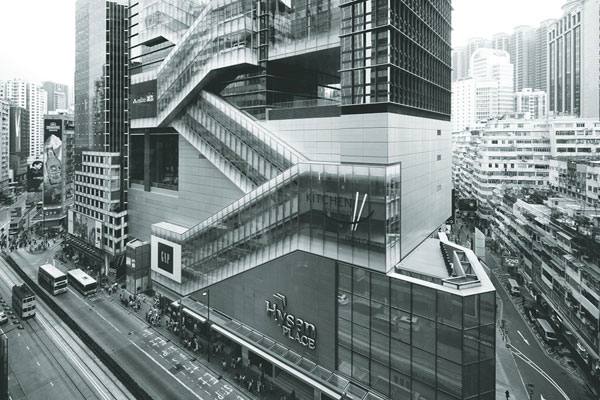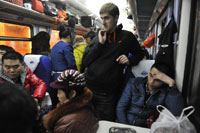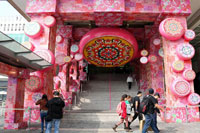Building innovation
Updated: 2013-01-28 14:00
By Caroline Berg (China Daily)
|
||||||||
 |
|
Hysan Place has been certified LEED Platinum for multistory voids, which improve airflow along the streets below. |
Anita Chan, director of the Hong Kong Economic and Trade Office in New York, says the city must create sustainable designs that will reduce its urban heat-island effect, improve air quality and provide good storm-water management systems while retaining its visual allure.
|
 |
Solomon believes New York shares many of these city-planning considerations.
Further cross-cultural cooperation between these two coastal cities, he adds, would provide mutual benefits in alleviating both cities' urban stress.
One example of such mutual aid includes the new Asia Society Hong Kong Center, completed in 2011.
"The Asia Society building is very important in Hong Kong," Solomon says.
"It is a model for the adaptive reuse of old buildings and a guide for future sustainable development."
New York company Tod Williams Billie Tsien Architects reclaimed a colonial-era British army explosives magazine - an artillery storehouse on one of Hong Kong's steep hillsides - to build the Asia Society's new home.
Like other projects the company has completed, including the David Rubenstein Atrium at New York's Lincoln Center (winner of a LEED award, an industry standard for energy-efficient design), the Asia Society building melds Hong Kong's natural jungle with the concrete variety.
According to Ah Hung, Hong Kong structures that represent a symbiosis between the city and nature, or the traditional and the contemporary, are rare. This is evident in the widespread disappearance of old Chinese-style architecture.
Hysan Place, another New York-Hong Kong collaboration, didn't include heritage preservation as a design principle but is considered one of Hong Kong's more sustainable modern buildings.
This skyscraper, certified LEED-Platinum, or Leadership in Energy and Environmental Design, includes sky gardens with views above neighboring rooftops and is punctured by multistory voids that improve airflow on the streets below.
|
 |
"Developing new buildings in Hong Kong that incorporate aspects of both the urban and the natural is so important," Ah Hung says.
"I think this type of 50-50 nature-to-building ratio should always be used."
Another contemporary concept in Hong Kong is the use of Victoria Harbor as a public recreational space.
"Hong Kong is working on new projects to rebuild its waterfront," Ah Hung says.
"Unfortunately, this is hard to do because the waterfront is already occupied by very important buildings."
Hong Kong's harbor has long been valued for its commercial importance.
"I grew up in Chicago where we have Lake Michigan and so many parks established for the sole purpose of recreation," Solomon says.
"The first time I visited Hong Kong, I was aghast at the lack of public recreational space on Victoria Harbor."
He attributed this difference to Hong Kong's background as first a community of fishing villages and later as a hub for shipping and trade.
The harbor has always been about business, while living on the water was traditionally considered dirty.

Now, Hong Kong's waterfront is the new frontier.
Proposed projects include the relatively simple, such as a Ferris wheel, and the ambitious, like the 40-hectare West Kowloon Cultural District. That area will integrate arts and culture in world-class facilities.
However, when thinking about extreme weather events back home like Hurricane Sandy, Solomon wonders if waterfront development in typhoon-prone Hong Kong is responsible or even feasible.
Yet efforts in cities, including Sydney, Vancouver and Barcelona, are proof that responsible waterfront development can be achieved, he points out.
As for Solomon and Ah Hung, their shared goal is to generate cross-cultural dialogue among architects and the wider community to realize the best possible designs for their cities.
Contact the writer at carolineberg@chinadailyusa.com.

 'Taken 2' grabs movie box office crown
'Taken 2' grabs movie box office crown
 Rihanna's 'Diamonds' tops UK pop chart
Rihanna's 'Diamonds' tops UK pop chart
 Fans get look at vintage Rolling Stones
Fans get look at vintage Rolling Stones
 Celebrities attend Power of Women event
Celebrities attend Power of Women event
 Ang Lee breaks 'every rule' to make unlikely new Life of Pi film
Ang Lee breaks 'every rule' to make unlikely new Life of Pi film
 Rihanna almost thrown out of nightclub
Rihanna almost thrown out of nightclub
 'Dark Knight' wins weekend box office
'Dark Knight' wins weekend box office
 'Total Recall' stars gather in Beverly Hills
'Total Recall' stars gather in Beverly Hills
Most Viewed
Editor's Picks

|

|

|

|

|

|
Today's Top News
Boston bombing suspect reported cornered on boat
7.0-magnitude quake hits Sichuan
Cross-talk artist helps to spread the word
'Green' awareness levels drop in Beijing
Palace Museum spruces up
First couple on Time's list of most influential
H7N9 flu transmission studied
Trading channels 'need to broaden'
US Weekly

|

|








